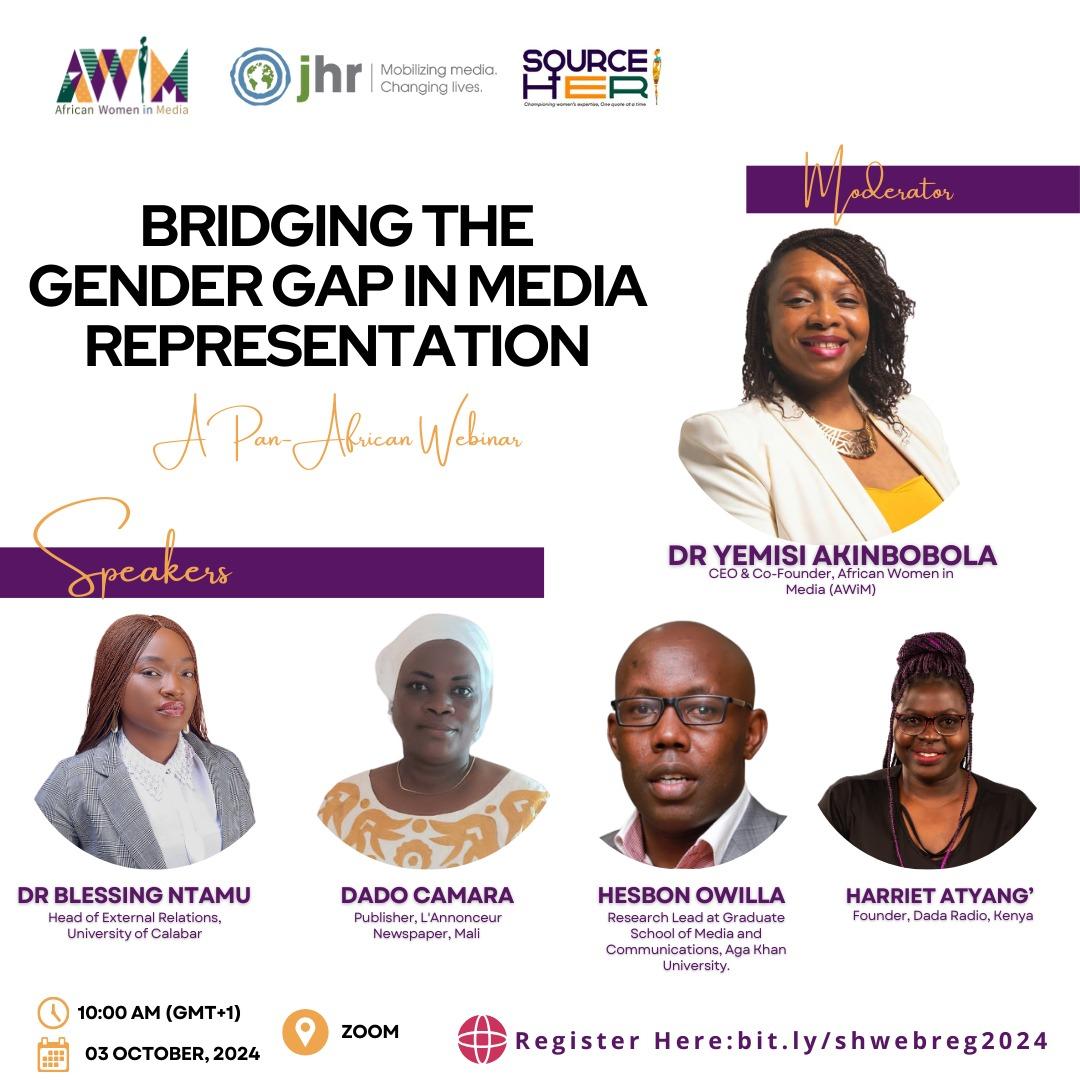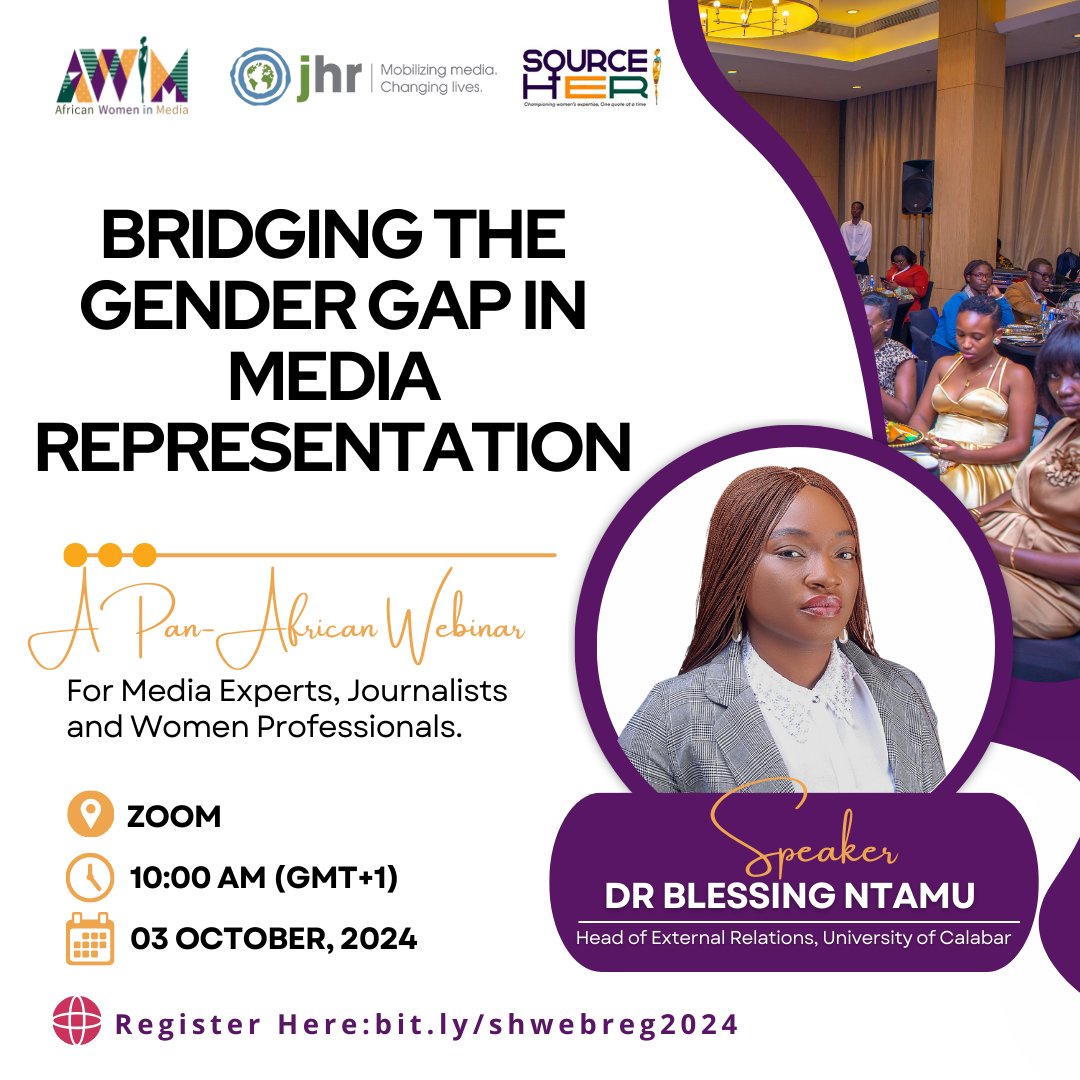Groundbreaking Workshop on AI and Technology-Facilitated Gender-Based Violence at AWiM24
Trending
Saturday May 31, 2025
Trending

The Pan African webinar is a professional collaborative initiative featuring African women in the Media, Journalist for human right( JHRnews) and AWiM’s ‘Source her program’ to address the Gender Gap in Media representation of women journalists, experts and professionals.
Introduction of the Webinar
Winfred Syombua, a representative of JHR opened the sessions by identifying that Women representation in the media is quite low and through their work at JHR, they have realised that every time media is addressing issues of national importance, women’s voices are quite low and men are often consulted as experts. She added that when asking for opinions about how particular issues affect the society, women are usually the last to be consulted, unless the issues are on gender based violence or or other gender related issues
Syombua said that at JHR, they aim to build the capacity of journalists for them to be able to spot issues and include the voice of women while building capacity of women for positive publicity which is one of the reasons behind the partnership of JHR with African Women In The media to launch ‘Source Her’ an online directory that canoonect journalists with women expert and aims to amplify the voices and coverage of women and enhance inclusivity.
Information about ‘Source Her’ by Joy Adigwe of African women in the Media
Source Her began in 2021 with a powerful idea; we wanted to create a spreadsheet that will help women connect with women experts. But as we discussed further we realized that the issues are larger than we thought. We discovered that only 20% of experts voices were women according to the global media monitoring project reports. For every 10 experts opinion in a news story, two were women. This brought about the birth of Source Her- a platform that connects journalists with professionals.
‘Source her’ now has over 200 women experts signed on the platform. Our community of sources, her champions which includes journalists and editors who have committed to increasing the visibility of women in the media. This will not be possible without our team, the co-founder of AWiM, Dele Ogunleye and our partner over the years, JHR ( journalist for human right).
Highlights of the Webinar
The webinar which was moderated by the founder of AWiM , Dr Yemisi Akinbobola had four guest speakers namely; Hariet Atchang, the founder of Dada Radio in Kenya, Dr Blessing Ntamu who is the head of external relation at the university of Calabar Nigeria, and Hesbon Owilla the research lead at Graduate school of media and Communications, Aga Khan university.
Barrier in Assessing Women Experts – Conversation with Harriet Atchang
Harriet is the founder of Dada Radio in Kenya and she has worked as a journalist for over 10 years in the rural communities of the country.

In your experience as a journalist, what has been the most significant barrier in assessing women experts for your story?
The first is under representation of women in every sector, when you look at women in stem for example, women are overly underrepresented, do, if you are looking for women expert in ‘Tech’, you will take a long time, another is lack of visibility, I have realized that women are doing good work at the grassroots level but most of our media do not focus on grassroots level, it is really difficult to recognize this women without visibility and as community radio. We are challenging ourselves to help with this visibility at Dada.
Time constraints are also another barrier and several women have had to reschedule interviews because of responsibility and gender roles.
Another barrier that is common in the area I have worked is that they see women as objects and men are domineering even at work places priority is given to male over the females as women coming last us naturally in some cultures.
What do you think about platforms like Source Her and how can journalists overcome these challenges and to improve gender balance with platforms like this?
Source Her- is a platform that helps under representation of women as many women will be able to register in this platform which will help journalists connect with experts and reduce the time consumed searching for professionals. I also registered with Source Her and might not get this opportunity without the platform.
Impact of Better representation on Mental health Awareness –Conversation with Dr Blessing Ntamu
Dr Blessing is a lecturer and researcher at the University of Calabar, Nigeria with a focus on behavior modification development, psychology, gender equality and mental health.

How do you think better representation of women experts in the media can impact mental health awareness and discussion?
Lack of awareness about me taking health issues particularly in Africa because of cultural and stereotypical 8ssue is alarming, id we have more representation of women in the media where. Women can handle issues and women listening or reading can get the right perspective, if we help women understand the difference between mental health challenges and being mentally healthy and being mentally Ill.
If women understand that seeking mental health help does not mean you are mentally ill and id we help women understand mental health challenges needs appropriate help and for this 4ight perspective we need women to tell the story from our own perspective and platform like Source can also organize more webinar bringing everyone on the platform together, there will be more opportunities for interactions and together we can jointly address issues like gender based violence, discrimination in the society and also encourage young women through with aspirations to take up leadership position and build strong women communities through mentor-ship where women can support each other.
Importance of the Environment in making Women’s Voices heard- Conversation with Dado Camara

Dado Camara is the publisher of L’Annonceur Newspaper in Mali
Camara describes the environment factor in Mali and also highlighted the importance of making sure the voices of women who are in the conflict areas are heard while also mentioning the roles of women in peace building and how they are contributing to addressing peace building in those locations.
Pressing Gaps in Media’s Coverage of Women –Conversation with Hesbon Owilla

Hesbon is a lecturer at Aga Khan university of graduate school of communication where he also serves as the research lead as a PhD candidate who focuses on political economy of media and political communication.
He led the 2024 research report on the state of women in Media representation and coverage of women in East Africa.
What would you say are the most pressing gaps in Media coverage of women and how do you see platforms like Source Her addressing these gaps?
The study we did in Kenya, Uganda and Tanzania shows that there is progress in the number of women giving their opinion on the editorial pages about things happening in the society.
However, the study highlights a number of gaps, which are: first, the disproportionate number of women compared to men in leadership position both at editorial and business circles. In Kenya for instance , women who occupy media leadership and the number of media organization that has women at the helm of affairs is only 11% .
Uganda and Tanzania is high compared to Kenya at 20% each and it is the same for business leadership which is even lower at the editorial level. This raises concerns as to what decisions are made on issues relating to women.
In our study, we went around East Africa talking to stakeholders from the academia, civil society and from the media industry and what has emerged is that we need to come up with policies with specific action points for different players in the media industry that strongly speaks to the subsystem of control at the media ownership level.
Another Gap worth paying attention to is the representation of women in newspaper headlines which is the pulse of what is happening in society.
The study shows that 55 percent of the newspapers concerned in Tanzanian and 39 percent in Uganda have not mentioned ‘Women’ in the headline of stories, in Kenya,not us 73 percent. The study was done at the time of 16 days of activism against gender based violence when the story of women should dominate the media yet funding showed the contrary.
We also discovered that most of the stories about women are accompanied with photos of which 22% of those stories have images that do not relate to the subject of discussion “women”
The key factor is that although there is improvement in women representation, men are still more than women. The research which seeks to advance gender equality in the media and civil society, exposed us to the fact that feminsation of the newsroom is not the only way to go despite being a good step, we realized that we need to sensitize both men and women to address issues that concern women’s progressive representation. This helped us develop curriculum and module in Kenya, Tanzania and Uganda for fellowship, workshop and training by providing journalists with information necessary to address these gaps.
We’re not gonna spam. We’ll try at least.

Copyright 2020. African Women In Media
Copyright 2020. African Women In Media
Recent Comments